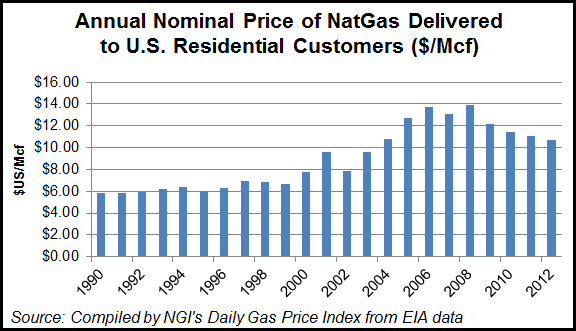AGA: Customers to Pay 5-10% More on Winter Gas Bills
Natural gas will remain the most affordable heating option for most residential customers this winter, with mild temperatures expected to keep any increase in gas bills at no more than 5-10% compared with last winter, according to the American Gas Association (AGA).

Customer bills are likely to rise slightly as a result of various market forces, but an abundant supply of domestic natural gas has contributed to lower production prices that, combined with robust storage levels, is poised to help ensure a steady supply at a lower cost than other home heating fuels, AGA said in its Winter Fuel Outlook.
“We see market forces working to offset any upward pressure in prices this winter,” said Bruce McDowell, AGA director of policy analysis. “Gas customers may still enjoy heating bills that are among the lowest of the past decade. Natural gas is still the fuel to beat.”
Customers who heated their homes with natural gas during the 2011-2012 winter heating season saw average savings of 70% compared to those using heating oil and 32% compared to those using electricity, AGA said.
Residential use of natural gas, which is the sector most sensitive to weather impacts, was 3,470 Bcf last winter, according to Energy Information Administration (EIA) data. That was up significantly from 2,989 Bcf in 2011-2012, the low point for residential consumption over the past five years. U.S. residential natural gas consumption during winter months has averaged 3,410 Bcf since 2008-2009.
Weather Services International (WSI) has said it expects temperatures nationally to average cooler than normal from the Northern Plains into the Ohio Valley over the next three months, with above-normal temperatures elsewhere, particularly across portions of Texas and the Southwest (seeDaily GPI, Sept. 25). And an early look at indicators suggests that later winter months may be characterized by more widespread cold, WSI said. Forecasters at the Farmers’ Almanac have said they expect the upcoming winter will be colder than normal for most of the United States (seeDaily GPI, Aug. 27).
There was 3,386 Bcf of natural gas in storage for the week ending Sept. 20, 179 Bcf less than a year earlier but 30 Bcf more than the five-year average, according to the latest EIA Weekly Gas Storage Report.
A quarterly update of various regional efforts to coordinate natural gas and electric markets released last month by the Federal Energy Regulatory Commission showed that the New England and Northeast generation markets will continue to be the most gas-dependent during the upcoming heating season (see Daily GPI, Sept. 20). The Commission recently passed an interim order that would make it easier for Northeast generators to substitute oil if natural gas was in short supply or was too high-priced. The Northeast has become heavily gas-reliant and preliminary estimates call for the Northeast to replace as much as 6.2-9.8 GW of coal-fired capacity with gas by 2015.
“The key to reliability and better coordination between gas and electric transmission industries is the continued development of a robust natural gas infrastructure along the entire value chain, so that natural gas can be delivered wherever and whenever it is needed to those who value it the most,” said Andrew Sotot, AGA senior managing counsel for regulatory affairs.
© 2024 Natural Gas Intelligence. All rights reserved.
ISSN © 1532-1231 | ISSN © 2577-9877 |

